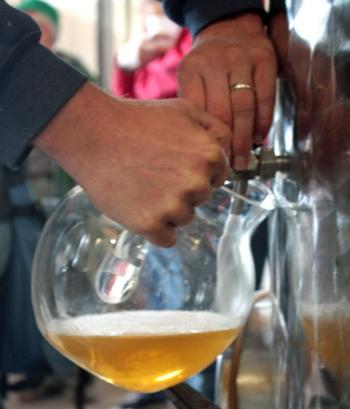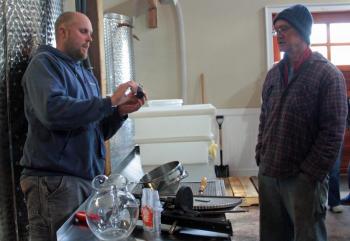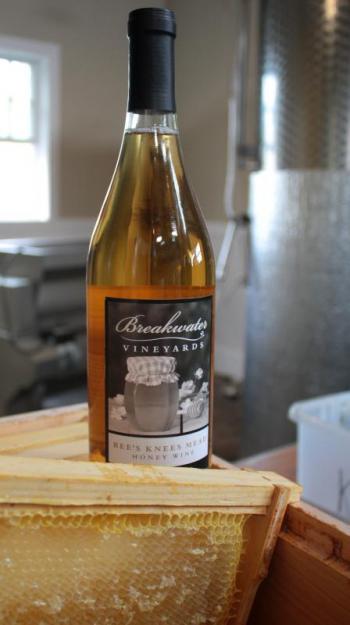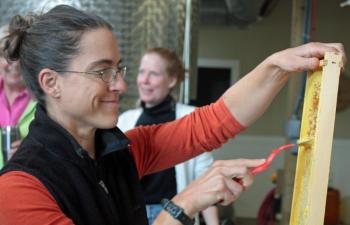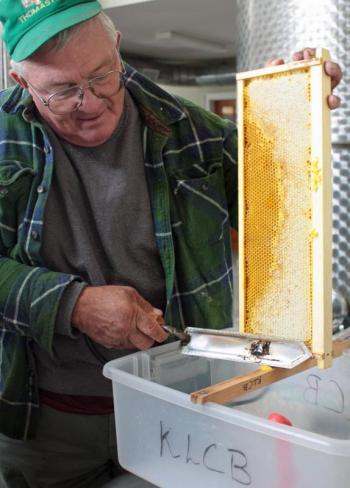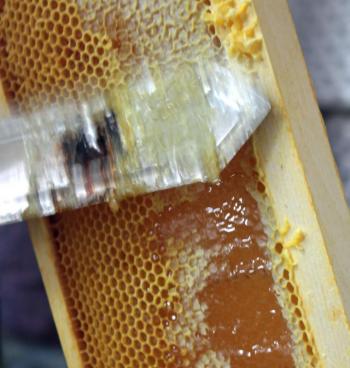Honey + Yeast + Water = Mead
OWLS HEAD — Since the 1920s, the catchphrase "the bee's knees" has come to mean the best, or most desirable person or something, as did other similar nonsensical phrases such as ant's pants, snake's hips, pig's wings and bullfrog's beard. The common feature is the comparison of something of excellent quality to some inappropriate or nonexistent part of an animal.
But when it comes to bee's knees, the hairs that cover them do the vital job of holding pollen collected from flower to flower, with little bits being lost along the way and providing pollination. While honeybees are busy packing their legs with pollen to bring back home to feed their brood, they are also collecting nectar, which eventually can become extra honey for a beekeeper to collect.
For winemakers, such as Jeanne Johnson of Breakwater Vineyards in Owls Head, honey is one of the three ingredients needed to make mead. The other two are water and yeast. It's that simple — and can even be made at home — though the process takes longer than to make wine for both hobbyists and commercial vintners.
"Mead fermenting takes four weeks or so, as it changes slower than wine, but we are making mead during the off times of the year as we can only get and/or harvest our grapes in the fall," said Breakwater Property Manager Jake Oliver. "I can get honey really any time of the year."
Mead needs a lot of sugar, but honey is so sweet it needs to be watered down to make mead. Oliver said it's a pretty simple process, once the right amount of the three ingredients is determined.
"It started out trial and error, to get the honey to water ratio right, to get to the brix [percentage of sugar by weight in a solution] we were looking for," said Oliver.
Once the sugar level is right, yeast does the job of fermenting it, converting the sugar to alcohol, in the simplest of terms.
The first year, honey from Johnson's hive at the vineyard was enough to experiment with and make a first small batch. For a batch of 1,000 gallons of mead, it takes 2,200 pounds of honey, a quantity they now source from Swan's in Albion.
The mead growth at Breakwater has been good, according to Oliver, especially given that they have only been making mead for four years.
The first year, a 160-gallon tank yielded 63 cases (a dozen 750 ml bottles in a case). The next year, 300 gallons made 126 cases, followed by 500 gallons and 200 cases.
"This year, we'll make 1,000 gallons and sell 420 cases," said Oliver.
Some customers, Johnson said, buy mead by the case, just like they do their wine.
"The growth in popularity of our mead has been a good problem to have," said Johnson.
In September, Knox Lincoln Counties Beekeepers held a monthly meeting at the vineyard, which was combination extracting party and mead-making lesson. Some club members took frames of capped and uncapped cured honey to extract after Oliver provided the basics of mead-making. He showed the group how they use a refractometer to determine the level of sugar in both their mead and wines, and then there was a tasting of a new batch of mead ready to be bottled.
For more information about Knox Lincoln Counties Beekeepers club, visit klcbee.com.
Breakwater Vineyards Bee’s Knees Mead can be found in wine stores around the Midcoast, and there are other brands of mead available too, such as Honeymake, with like lavender, blueberry and even elderberry, which we have been told is a popular seller at local stores.
Related story:


